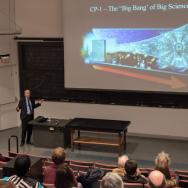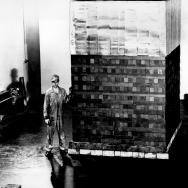Most of the people who built the first atomic bomb did not know what they were doing. But the scientists did.
Some of these Manhattan Project scientists never betrayed a hint of misgiving. But a group based at the University of Chicago, where the historic controlled nuclear chain reaction had taken place, began to push back. Even before the United States dropped atomic bombs on Hiroshima and Nagasaki, they signed a document urging the military not to use nuclear weapons on people.
In the aftermath of World War II, many of them formed the Bulletin of the Atomic Scientists, which has been dedicated ever since to informing the public about technologies “with the potential to end civilization.” To this day, the Bulletin is housed at the University of Chicago, though its mission has expanded to address such global threats as terrorism, cyberattacks and climate change.
Robert Rosner, the William E. Wrather Distinguished Service Professor at UChicago and chair of the Bulletin’s Science and Security board, called the Bulletin “a canary in the mine,” a forum for experts to debate whether a given conflict or development should give the wider world pause.
On Jan. 23, the Bulletin will hold a news conference unveiling the 2020 for the “Doomsday Clock,” which symbolizes how close humanity is to apocalypse. (The clock is currently set at two minutes to midnight—the closest it has been since the height of the Cold War arms race.)
“The number of ways in which we walk blithely into Armageddon is very high,” said Daniel Holz, UChicago professor of astronomy and astrophysics and Science and Security Board Bulletin member.
Conscience and crisis
Leo Szilard, along with Albert Einstein, was one of the two scientists who wrote to President Roosevelt in 1939, warning him of the potential of an atomic bomb—and that Germany might be able to build one. Six years later, when he learned the bomb had been dropped on Hiroshima, Szilard wrote a note (on UChicago Quad Club stationery) to Gertrud Weiss, the physician and professor of medicine he would marry in 1951, calling it “one of the greatest blunders of history.”

In June 1945, Szilard had been one of a group of prominent Manhattan Project scientists who signed the cautionary document known as the Franck Report. When that document failed to progress, he circulated a second petition against the use of the weapon signed by nearly 70 fellow Manhattan Project employees. Neither document was heeded.
One day after the Hiroshima bombing, Szilard and other prominent Manhattan Project scientists met to discuss how to inform the public about science and its implications for humanity. By September, they had formed the Bulletin of the Atomic Scientists of Chicago—later shortened to just the Bulletin of the Atomic Scientists as its membership grew. They shared a mission: “to equip the public, policymakers and scientists with the information needed to reduce man-made threats to our existence.”
“For the first time in modern history, scientists were saying that it was necessary to make judgments about what to do with their inventions,” said John A. Simpson, a young UChicago scientist who chaired the initial meeting and who would go on to shape the field of cosmic ray detection.
For example, one of Simpson’s first priorities was lobbying to transfer as much oversight over nuclear technology as possible to civilian government, rather than the military. The Atomic Energy Act of 1946 reflected his and other scientists’ efforts, creating a civilian-led Atomic Energy Commission (today the Department of Energy), which would control nuclear weapons development, as well as the development of nuclear energy for peaceful purposes.
Clocking humanity’s remaining minutes
The first few Bulletins were mimeographed collections of articles. But as the publication expanded, its editors decided to try to appeal to a wider audience with a designed cover, so member and artist Martyl Langsdorf agreed to produce a cover. In response to the urgency she felt from the meetings, she designed a minimalist but memorable clock with its hands set at seven minutes to midnight.
Ever since, the Bulletin has set the timeline for humanity by this measure. The decision to move (or to leave in place) the minute hand of the Doomsday Clock is made every year by the Bulletin’s Science and Security Board in consultation with its Board of Sponsors, which includes 13 Nobel laureates.
The furthest the clock has been set was 17 minutes to midnight, in 1991, following the collapse of the Soviet Union and the signing of the Strategic Arms Reduction Treaty. The closest it has been is two minutes to midnight; first in 1953, when the U.S. and Soviet Union both tested thermonuclear weapons, and then in 2018, citing “a breakdown in the international order” of nuclear actors as well as the continuing lack of action on climate change.
“The next 10 years will be critical for climate,” said Holz. “If we act now, we might avoid some of the worst, civilization-threatening outcomes. The danger of nuclear annihilation is on the rise, too. These are compounded by the deliberate erosion of facts and truth, which pose grave threats to society.
“But that’s something all of us can help address. Agitate for change! It’s not too late.”








